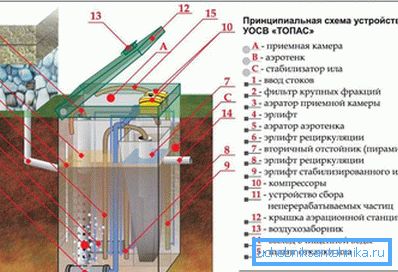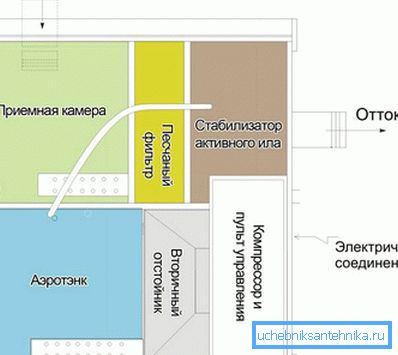How does the septic tapas: device features, the principle of
Not so long ago, the owners of country sites, houses and cottages quietly treated cesspools and the simplest septic tanks of concrete rings. Times have changed, and now it is customary to equip the sewage system with the help of more advanced systems - biological treatment stations. Their main difference is the quality of wastewater treatment. If in the cesspools water only passes through the drainage layer or simply accumulates, and in concrete septic tanks the filtration is carried out by settling, then such equipment is much more complex.
Many consumers make their choice in favor of a septic tank, which is capable of purifying water to the point of pure water. This water is called technical and can be reused for irrigation.
Features of the device

Septic perfectly copes with the task of cleaning and disposal of wastewater. Experts note a number of advantages:
- high degree of wastewater treatment - up to 99%;
- compactness - the septic tank has a shape elongated in height, so it will not take up much space, most of it will hide at depth;
- absolute tightness - this results in excellent waterproofing and the absence of unpleasant odors, which are observed in the places where cesspools and some septic tanks are installed;
- noiselessness;
- automation;
- no need for insulation (in the northern areas, taking into account the winter period, it is necessary to warm) - the septic tank heats up during work.
A significant drawback for some will be the need to permanently connect the station to electricity, because an important element in operation is a pump that simply will not work without electricity. If you try to start a septic tank without electricity, it will be clogged, since the movement of drains in the septic tank occurs forcibly.
Other disadvantages: high cost, inability to process substances containing chlorine, hence the need for careful control of sewage discharged into the sewer system.

The model range is represented by septic tanks of different sizes and configurations. The most inefficient is Topas 5, it is designed to serve a family of 3-5 people, the largest and most productive septic tank is Topas 150, it will serve several houses, a hotel, a camp site, an enterprise. Septic Tapas 5, 8, 10 require periodic cleaning of accumulated sediment. Pumping sludge from more productive models is not required. For more information, please visit the official representative’s website https://topas-site.ru/. There is also available online selection of models by known parameters.
Scheme of work
The construction of the septic tank consists of four chambers. First, the effluents enter the receiving chamber, where large fractions remain — particles that are insoluble in water are filtered out. Then the waste water is pumped into the second chamber with the aeration tank installed. This device saturates the wastewater with air, and aerobic bacteria, which actively process the organic pollution that has passed the first stage, come into operation here. Particles are separated again. At the next stage, the final sedimentation takes place in the third chamber, here the sludge settles to the bottom.

The second and third chambers must be periodically cleaned of sediment, but it accumulates a little and, moreover, it does not require special equipment. Cleaning is carried out independently about once every 4–6 months. It all depends on the frequency of use. Purified water enters the last chamber, where a fine filter is installed, passes filtering and is discharged outside.

Air-lifts are provided in the device, along which drains are lifted and pumped into the next chamber.

The main work in the septic tank is performed by activated sludge - it is, in fact, sludge, saturated with live microorganisms. That is why chlorine compounds, gasoline, alkalis and other substances that can destroy bacteria cannot be drained into the sewage system.
Video: what should not enter the septic tank
Features of operation
For the septic tank to work smoothly, there were no problems, it is necessary to follow the rules of its operation.
- First, periodically clean the septic tank from accumulated sludge: Topas 5 - once in 3 months, Topas 8 - once 4 months, Topas 10 - once every five months. Do not allow the septic tank to overflow, this will cause a significant deterioration in the quality of cleaning, and in the future and complete clogging of the septic tank.
- Secondly, it is necessary to change membranes in compressors every two years.
- Third, a bacterial filter needs to be replaced. This should be done every 12 years.
- Finally, for the first cleaning, call a specialist, afterwards, already knowing how to properly perform all the necessary operations, you will be able to clean the septic tank yourself.
Video: Topas service
Topas is an excellent choice for those who for some reason cannot connect to the central sewage but care for the environment. It will solve your problems with waste disposal under the conditions of operation and maintenance.